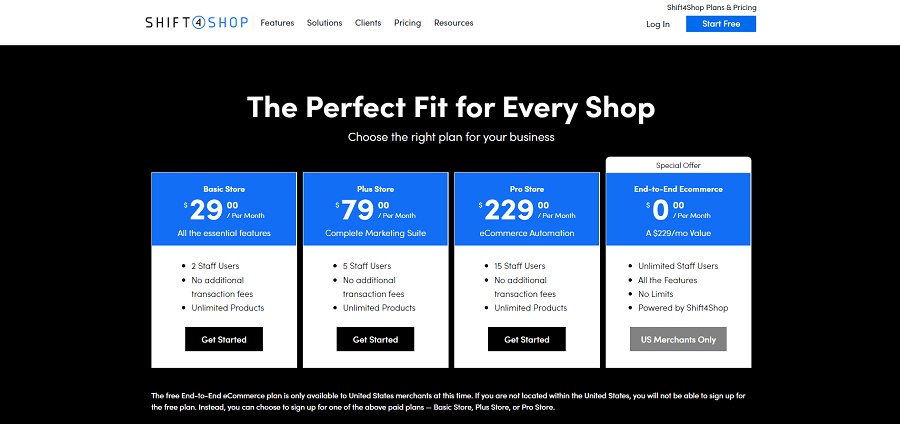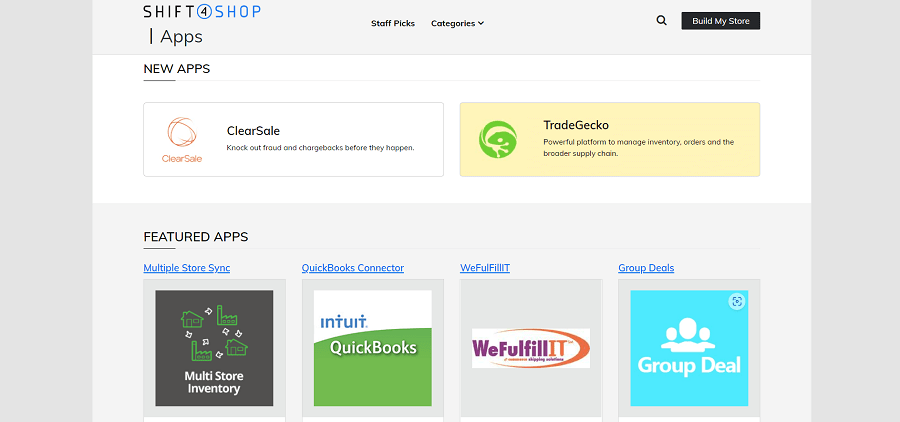
Business Kick-Starter Guides
How to Start an Online Boutique in 2025? [Simple 10 Steps Guide]
Coming up with the perfect formula for starting and running an online boutique will always be the topic of discussion...
Shift4shop vs. Shopify: the Ultimate eCommerce Comparison
eCommerce

Shift4Shop and Shopify are two of the most popular eCommerce software, with the former hosting over 200,000 customers and the latter operating across close to 2,000,000 online stores globally. Both provide dropshippers, with broad-ranging collections of web-building tools and features as well as full-time support in running their businesses.
When it comes to choosing which one to base your dropshipping store on, it can become a little bit overwhelming. On one hand, as previously specified, Shif4Shop has hundreds of thousands of satisfied customers with over 3 billion in annual transactions, as stated on their website. On the other hand, Shopify is currently ranking in the top four leading eCommerce platforms since July 2022.
Having said that, it’s challenging to rule out which one is better than the other. Therefore, we’ve prepared the ultimate Shift4Shop vs. Shopify comparison to give you an idea of what each platform offers, what unique features they possess, and what differences can be spotted.
Shift4Shop is an eCommerce platform that offers entrepreneurs the necessary tools to launch and manage their eCommerce businesses. Shift4Shop is open to all kinds of sellers, welcoming both beginners and professionals, interested in tapping into the eCommerce industry. Since its establishment in 1997, the platform has been equipped with more than enough features to assist you in designing your website from top to bottom.

Shopify is an all-in-one eCommerce solution that gives entrepreneurs the required means to build thriving online stores and operate them with remarkable ease. Shopify is considered to be one of the best user-friendly platforms for creating a virtual storefront. It comes with many built-in tools that enable merchants to design, set up, and grow their businesses.

Despite both serving entrepreneurs with equally great web-building options, Shift4Shop and Shopify do possess quite distinguishable features from one another. Depending on what is required for their businesses to blossom, merchants may prefer one platform over the other. That being said, the following key differences might help you in choosing between Shift4Shop and Shopify, based on which one is more suitable for your dropshipping company. To cover all qualities, we’ll be dividing the comparison into a few sections:
Both Shift4Shop and Shopify come with a variety of features, both basic and advanced, essential for setting up your store with everything needed to go live – from design tools and store domain name to sales channels and dropshipping payment gateways.
Shift4Shop gives dropshippers a good collection of the most essential tools they’ll need to launch their stores. Keep in mind, however, that some might be available only for specific subscription packages.

Shopify has almost the exact collection of fundamental web-building features, out of which, once again, a handful aren’t available for all subscription plans.

The features both platforms provide are close to identical, with no substantial differences.
Having at your disposal an excellent web builder will significantly change the course of your dropshipping business’s growth for the better. After all, first impressions are almost always what locks in the customers’ opinion of your online store. Shopify and Shift4Shop offer practical designing tools you can check out in the sections below.
Shift4Shop stores come with well-furnished web editors, allowing dropshippers to create professional webpages that are bound to lure in visitors. Some of the web design elements the platform supplies its users are the following:

Shopify is equipped with a decent amount of design options that enable users to create a stunning customer-friendly website with attractive visual elements and engaging content. Here’s what Shopify web design features the platform offers:

On one hand, Shift4shop offers a bigger number of free templates, while Shopify’s cost-free themes are narrowed to only a few, but users can still purchase templates within affordable prices. On the other hand, Shopify provides bigger freedom in customizing the templates, while Shift4Shop is slightly limited in this aspect. Despite that, Shift4Shop users are still offered enough options to personalize their websites.
Both platforms offer affordable pricing plans to help entrepreneurs, especially newbies to the dropshipping industry, to get the ball rolling at the beginning with at least a basic plan, and for later, provide them with more advanced subscription options.
Shift4Shop has four pricing plans, all of which come with different feature options:

Shopify provides users with three subscription packages along with a free 14-day trial, allowing you to see how the platform functions and giving you time to set on a pricing plan.

Both platforms have almost exact prices for their subscription packages with the main difference consisting in the fact that Shopify offers a 14-day free trial, while Shift4Shop has an additional free plan available for US users only.
Even though Shift4Shop and Shopify provide you with plethora of features to build a prospering business, third-party extensions are often needed to help you in managing your tasks.
Shift4Shop users can expand the functionality of their stores by taking advantage of the platform’s +300 plugins and add-ons, all of which are available on the Shift4Shop App Market. You’ll stumble upon both free and paid apps with prices ranging anywhere from $19/month or less to $100/month and higher. Dropshippers can choose their extensions from over 20 categories, including cart abandonment, affiliate software, fraud prevention, dropshipping automation, and social media tools to name a few.

Shopify-based stores can benefit from well over 1000 plugins, a good amount of which are completely free or come with both free and fee-based plans to choose from. Prices vary significantly, depending on the features offered, however, rest assured you’ll find a large pool of affordable extensions in case the free ones don’t meet your expectations. All apps can be installed from the Shopify App Store, where you can easily browse for add-ons by using the search bar and inserting a search query such as marketing tools, finance management, product review, store design, etc.

Note: To give you a preview of the choices, take a look at these best dropshipping apps for Shopify and best Shopify email marketing apps.
Shopify has the upper hand in this section, offering a wider selection of plugins than Shift4Shop. However, both of them offer all kinds of third-party extension that help in managing numerous areas of your business.
SEO or Search Engine Optimization comprises of practices that organically increase your online store’s visibility on search engines, and thus lead to more visitors and sales. Here’s how both platforms let you build an SEO-optimized dropshipping store.
Shift4Shop will help you optimize both your on-SEO and off-SEO by giving you the following tools at your disposal:

Shopify will assist you in securing your website a high ranking position by offering you the almost exact same SEO-improving elements, some of which are:

Both Shift4Shop and Shopify offer basic SEO features that’ll do a great job in optimizing your dropshipping store.
Having your platform’s support at all times can save you a lots of headaches, which is why you need to make you that you have access to optimal customer service. Here’s how Shopify and Shift4Shop help their customers in solving any issues related to their businesses.
The Shift4Shop support service can be contacted at all times, either by phone and live chat or through their ticket system. When it comes to resolving smaller inconveniences, users are encouraged to turn for advice to Shift4shop’s other means of customer service which include their so-called Knowedgebase, HTML guide, and online forum community.

The Shopify customer service team can be reach 24/7 via multiple contact forms: live chat, phone, and email. For less urgent matters, the Shopify Help Center provides an extended list of topics you can consult – their database includes article on various eCommerce introductions, admin issues, checkout processes, sales channels, payments and POS transactions, taxes and customs, and list goes on and on. In addition, you can also visit the Shopify community, where you can engage in conversations with fellow entrepreneurs as well as take advantage of these Shopify apps for customer support.

The Shopify customer support center can be easily contacted by phone, email, or live chat, while the Shift4Shop customer team is available either by live chat, phone, or the ticket system.
To sum up their differences in just a few poins, as any other eCommerce platform, Shopify and Shift4Shop do come with both advantages and disadvantages found in different areas of their services. Nevertheless, despite coming with a few imperfections, it doesn’t mean they aren’t great platforms. On the contrary, it means that based on your store’s requirements, one of them might be slightly more suitable for your business than the other.
Pros
Cons
Pros
Cons
Opening a dropshipping store on one of these platforms will evidently require you to recruit a dropshipping supplier. However, when going through the selection process, it’s not enough to only pay attention to the products they offer, but to their dropshipping service as a whole.
To put it simply, despite stocking your online store with high-quality products, your supplier should be able to provide you with a smooth dropshipping experience by furnishing you with a practical integration as well as converting your store into an automated dropshipping business.
Luckily, you don’t have to look much further as BrandsGateway will supply you with all of the above. From a comprehensive catalog of luxury clothing and accessories, high-profit margins, and convenient eCommerce integrations to dropshipping automated orders and in real-time inventory updates – BrandsGateway has it all. So, let’s see how you can start dropshipping with BrandsGateway with both Shift4Shop and Shopify-based stores.
BrandsGateway offers an easy Shift4Shop integration that’ll automate your business and provide you with tons of perks that’ll help you in operating your store.
To integrate your Shift4Shop store with BrandsGateway, you’ll only need to go over a very few simple steps:
BrandsGateway gives Shopify users a simple Shopify integration that’ll provide them with the most enjoyable and stress-free dropshipping experience.
Integrating your Shopify shop with BrandsGateway will only take you a moment as the whole process takes around five steps to complete:
No one! Despite their visible differences, at the end of the day, both Shift4Shop and Shopify represent excellent eCommerce platforms to build your business on. There is no right or wrong choice when it comes to making a selection as this decision solely depends on your personal preferences and requirements. In other words, choose the platform you believe will help you achieve your business objectives.
Shift4Shop offers dropshippers four subscription packages, starting with the Basic Store package of $29 a month, the Plus Store of $79/month, the Pro Store of $229/month, and the End-to-End eCommerce for 0$/month (for US-merchants only).
Shopify provides users with three pricing plans with a monthly fee of $24/month for the Basic Plan, $69/month for the Shopify Plan, and $299/month fo the Advanced Plan.
Yes. Shift4Shop is a dropshipping-friendly eCommerce platform, providing you with all the necessary tools to help you create and launch your online dropshipping store in no time.
Yes. Shopify is a user-friendly and easy-to-use platform that includes many built-in features but also offers the possibility of simple integration with diverse third-party tools. In other words, it’s the perfect platform for anyone to open and grow a winning dropshipping business smoothly.
Both Shift4Shop and Shopify can be considered to be among the best web-building platforms, offering excellent features for creating a thriving dropshipping store.
What is dropshipping?